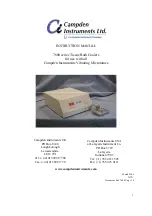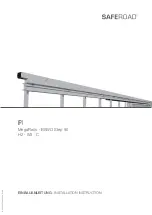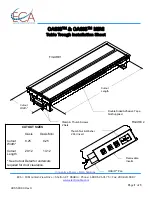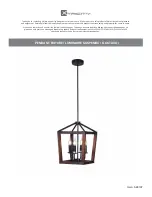
Granudos 45/100-CPR Touch XL + Touch + S5
Dosing unit
Index: 02
Date modified: 06/06/2019
OI No.: BA SW 003-02 Granudos 45-100 CPR Touch+Touch+S5-Dosiereinheit EN.docx Page 18 of 58
The acid dosing is performed using a peristaltic pump. Peristaltic pumps
are able to convey even the smallest dosing quantities reliably and
evenly, even when air or gas bubbles are trapped in the suction line.
Rotating rollers press the dosing hose against the casing wall, which
pushes the liquid in the hose out from the rollers while simultaneously
feeding behind it. It is exceptionally reliable and easy to operate.
The peristaltic pump sucks the acid through the suction lance
from
the acid canister. The fill level in the acid canister is determined for the
empty signal using a level switch.
Use acid based on 37-50% sulphuric acid as a pH reducer.
Concentrated
hydrochloric acid
destroys the peristaltic pump –
dilute
to below 10%!
In solutions consisting of
sodium bisulphate
"dry acid"
, do not use
concentrations above 20%
(approx. equivalent to 10% sulphuric acid). It must be considered
whether the acid capacity is sufficient for the neutralisation.
Tip!
In special cases, e.g., if the water is very hard and/or has a high pH
value and/or a high dosing performance is required, it is
recommended to use hydrochloric acid instead of sulfuric acid, to
prevent the potential formation of gypsum residue due to high
sulphate concentrations in the buffertank (optional).
3.2.7
Granudos Control unit
See operating instructions “Measuring and control unit
CPR-Touch GRANUDOS CPR
Touch XL
“, no.
BA
MR 001
.
See operating instructions “Control unit
GRANUDOS Touch
“, no.
BA
SW 010
.
See operating instructions “Control unit
GRANUDOS S5
“, no.
BA
SW 014
.
3.2.8
Dust extraction (optional)
The dust extraction serves to sup-
port the prevention of dust in the
GRANUDOS dosing system. The
use of granulates with an in-
creased dust content may lead to
a minor dust discharge at the de-
vice. This will subsequently settle
on the protective cover. To pre-
vent this, a slight underpressure is
generated by means of a motor
with a fan
. The dust is
suctioned through the flushing
pipe into the fan container via a hose
. The dust remains in the Granudos’ dissolving
system via the connection line
to the flushing tank and the circulating water.
The stirrer is mounted on the stirring container's cover. To ensure aeration, a bent nozzle is
attached on the lid on the side for the water recirculation.
Figure 10, Acid
dosing pump
Figure 11, Dust extraction
51
49
50
52
















































